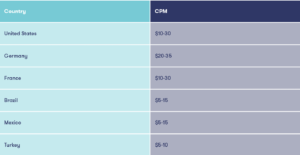Figuring out what to charge for sponsorships is tricky business. You might search online to see what others say, but advice varies wildly making it difficult to suss out a fair fee. The reality is that pricing is affected by a myriad of factors, some more measurable than others. We’ve outlined what you need to know, and how you can calculate a fair fee.
Want to get paid for your content? Sign up to our platform to get matched with relevant brands.
What are the different types of promotions?
Promotions can fall into many categories, but these are two of the most common types that advertisers go for.
Dedicated videos – In these promotions, the entire video is devoted to the brand. In other words, it’s the main topic of the video. You might want to consider this option if the product very closely aligns with your brand. For example if you’re a photographer and decide to promote a camera. Since it’s not your ‘usual’ content, dedicated videos can be lower in views. When a video is in a format your followers aren’t used to, they might not click on it as much. If your audience watches your content more because of your personality, rather than the type of content you produce, the impact on views might not be that big.
Integrated videos – In integrated videos, only a smaller portion of the video is sponsored (e.g 30-90 secs). The product should also be relevant to your channel, but it isn’t the main topic of the video. These types of sponsorships don’t normally have as much of an impact on your normal view count, as it only takes up a small portion of the content.
What are the different sponsorship pricing models?
The way that creator fees are calculated will vary depending on the advertiser. These terms and acronyms might look a bit daunting at first, but don’t worry — they’re quite easy to learn. Here are the most common models:
CPM — Cost per mille – In Latin, mille means a thousand, so this means cost per thousand views. If you go down this route, you’ll earn a certain amount for each 1000 views you bring. You firstly negotiate the CPM with the advertiser and get paid after the decided period based on the CPM you negotiated multiplied by the views the content received within the agreed time period (e.g. 30 days).
CPA — Cost per action. In this model, your earnings are based on every tracked action. The action is predefined, for example, it could be a purchase or a website click.
CPI — Cost per install. This deal focuses on the number of installs you get through a tracking link. In this pricing model, you get paid based on the number of installs made through a link in your video description.
Fixed fee — When you work with this model, you’ll get a predetermined fee agreed on with the advertiser. Since it is set before the campaign, it isn’t dependent on the performance of the video you’re about to do. Instead, the fee is calculated based on the performance of past videos, which are analyzed to predict the number of views your video will get. This prediction along with the CPM can be used to negotiate a fee.
Pricing your YouTube sponsorships
Factors to take into account:
- Where your audience is located
- How many views you get on average
- The length of the sponsored content
What these mean in practice
- Audience: When sponsors talk about geos, they talk about where your audience is located. If you look at your metrics, you may see that not all of your audience is necessarily based in the same place. This impacts your sponsorship fee, since countries are often priced differently.
- Views: The best way to understand your channel value is to find out your average 30-day views. An easy way to find this out is by signing up to Matchmade, where you will be able to view these stats on your dashboard. While there might be specific types of videos that make more views, and others less, the average views will give the sponsor a guiding line and help you propose a price that is calculated according to industry standards.
- Length: The longer the content the more money you can charge. So 30-second integrations should be significantly cheaper than dedicated ones that take the whole video. Of course, in exceptional cases integrated videos might require a lot of production, in which case the fee can be increased.
So, how should I price my channel?
Hold on to your seatbelt as we’re going to dive into a bit of math in here. This pricing gives an idea of how to price yourself for a 60-second integration at a fixed fee. These guidelines are based on what we’ve seen work over thousands of deals that we’ve carried out ourselves. Note that these are mostly based on gaming channels, and prices vary by niche and scarcity.
Usually, the best way to price your channel is to understand where your audience is located. Here are some examples of CPM prices (the cost per thousand views) for each country.

The price in dollars is for each 1000 views you expect to have based on your 30 days average views. So if you are expected to get 10,000 views and the majority of your audience is from the US, it could make sense to propose $200 for a 60-second integration. If you have a diverse audience, take them into account and price it according to the percentage.
The price of a dedicated video will be more. As a guide, you can use the above method and then multiply by at least 1.5 to calculate a proposed fee.
Once you have done a fixed-fee deal, advertisers will have a better understanding of your performance should they wish to propose a sponsorship that is conversion-based.
No one-size-fits-all approach
There isn’t a one-size-fits-all approach to pricing, but these factors can help indicate the range that you should be aiming for. Although the industry is beginning to standardize, there will always be high and low prices, and even your own fee won’t necessarily stay the same. What we can say is that the best price is the price that makes both you and the advertiser happy. It’s this that leads to a successful partnership and lays the groundwork for future collaborations.
If you’re interested in finding relevant sponsorship opportunities that pay fair fees sign up to our platform.
You can learn more about how to approach sponsorships and build meaningful relationships with advertisers in this guide.



